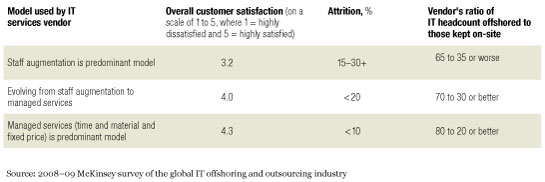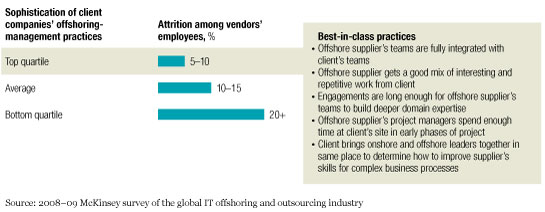Despite the global downturn, the IT offshoring and outsourcing industry has continued to grow, though at a slower pace. The recession’s main effect has been heightened competition among the hundreds of IT service providers that handle a variety of tasks for global corporations. Now, a small group of winners is emerging from the fray, threatening to erode the offshore franchise of many Tier-1 and Tier-2 suppliers in countries such as India, the Philippines, and Russia.
Our 2008–09 survey of the global IT offshoring and outsourcing industry—covering 200 relationships among companies in Asia, Europe, and North America, including 65 of the Fortune 200—shows that these rising suppliers have had a broad impact. In fact, they are redefining many traditional management practices; changing the long-standing model for contracting offshore services, by focusing on the quality of services delivered rather than the usual benchmarks of costs per offshore hire; collaborating with clients in new ways; and gaining more control over outsourcing strategies.
What’s more, our results show that this new group of IT service providers is developing the broader and deeper pools of talent that global clients increasingly demand and using progressive techniques to manage and retain these workers. Perhaps that’s why such companies had the highest rankings for overall client satisfaction and employee retention in our survey, logging high scores across their entire client base and showing a consistent year-on-year improvement. By contrast, clients thought that most of the other established Tier-1 and Tier-2 companies were just doing an “average job,” and their performance isn’t improving. In another major shift, they can no longer win bids solely by differentiating on price, since almost all suppliers are now cost competitive.
Meanwhile, the leading providers’ characteristic practices are becoming more important. The four most important practices our survey identified are a new delivery model for services, a greater ability to supply business expertise rather than just IT know-how, more successful talent management, and clearer metrics for judging results. We expect that these practices will become more important and widespread as clients push the offshore industry to achieve higher performance levels and provide more sophisticated offerings.
Changing the delivery model
The most widely adopted model for delivering offshore services is called staff augmentation, but it is ceding ground to the more robust managed-services model. Under the traditional system, clients pay for each staff member a supplier adds to complete an IT contract—from the help desk operators who handle service problems to Java or mainframe software developers. Clients seek the lowest cost per head, which encourages stiff price competition among suppliers, but gives the vendor limited incentive or accountability for the outcomes and quality, as no specific requirements or deliverables are specified in the contract.
Under the managed-services model, suppliers agree to deliver a specified capability or functionality with a desired level of service for a given price: for example, they contract to provide data center support for a year within certain volume and downtime parameters or to support production operations with clear, mutually agreed upon service levels. This model requires a higher level of trust, as clients cede more control to suppliers. Clients benefit by locking in the services they need without having to manage variable resource requirements at the offshore venue tightly.
One pharma company moving to the new model invested considerable time upfront with its offshore supplier to document the underlying business processes and build internal capabilities (such as management tools, standardized work statements, and templates for service-level agreements) where it wanted a high level of support. Then the company created and managed a knowledge transfer process to ensure a successful and timely transition to the new delivery model. Although several months passed before the benefits started to accrue, the quality of the supplier’s work improved and the company shifted additional operations to it. Overall productivity rose.
Our survey shows that client organizations relying primarily on the managed-service rather than staff augmentation model reap great advantages: the best and most efficient work, the highest satisfaction levels, and the lowest attrition rates among their suppliers’ employees (Exhibit 1). Managed services may also make it possible for clients and suppliers to improve offshore results more than the traditional approach does. According to an executive at the pharma company, “While you do have to invest time up front, managing it on an ongoing basis is much less of a hassle. And you actually get more control when you focus on deliverables and things that matter rather than micromanaging the team remotely, which doesn’t work and results in a lot of frustration on both sides.”
The more satisfying model

Developing business domain expertise
The work suppliers undertake is shifting significantly as well. Historically, clients have sought an offshore supplier with experience in their technology platforms—for example, skills in a particular programming language or in managing server installations. These contractors supported commodity onshore business processes for their clients at a significantly lower cost than the clients’ could achieve themselves. The new paradigm moves the suppliers’ work up the value chain. More and more, contracting revolves around expertise in specific business processes, or domains, such as loan origination skills, credit card processing, or account opening.
When client and supplier work regularly within a domain, the supplier can deepen its expertise and leverage it in subsequent assignments. The benefits can be substantial: some survey respondents report efficiencies of 20 to 30 percent for at-scale domains. So it usually makes sense for a client to limit its offshoring in any domain to a few suppliers, which, over time, gain a better understanding of its objectives and requirements. As these relationships become more mature, as much as 60 to 70 percent of IT support for that business domain can be offshored effectively.
According to a banking company’s CIO, this kind of focus on business domain and mutual investment in domain expertise forces clients to develop a clearer view of the way their demand for offshoring services will evolve over the medium term. They should then communicate that understanding to help their suppliers develop business depth in those domains. From the perspective of a supplier, investments to build its expertise can help it to win repeat business and, ultimately, to become the client’s strategic partner.
Managing talent better
Of course, the economic slowdown has led to a degree of slackness in some of the normally tight markets for offshore labor, though the suppliers in our survey report that they still face strong competition in hiring and retaining highly skilled talent. But the survey found that in some client–supplier relationships, attrition rates are low and satisfaction is high. In these relationships, talent is managed in a significantly different way.
The key to minimizing attrition is for clients to give suppliers wide-ranging authority to manage their teams locally. In part, that means working cooperatively with suppliers, developing their local team leaders, and letting them manage projects themselves. These best practices can make attrition rates fall dramatically (Exhibit 2). In one instance, a client closely integrated its domestic and offshore teams and sent its home-based employees to the offshore site, where they spent a substantial amount of time during the project’s early phases. As part of the effort, the client brought onshore and offshore managers together to determine how to build the supplier’s skills for a complex business process. Attrition rates dropped to 10 percent, from the 30 percent levels common in the offshoring industry. As one executive put it, “our philosophy shifted away from ‘supplier talent management and supplier attrition are supplier problems’ to develop a partnership.”
Talent-management support

Clients can also help their suppliers to reduce attrition by mixing more challenging work (such as high-end development projects) with repetitive tasks (say, system maintenance, production support, or simple enhancements of previous work). A financial-services firm, for example, gave a supplier both the routine chore of maintaining and providing production support for finance P&L systems and the more demanding job of creating a next-generation derivatives platform. When more of this kind of challenging work comprises 30 to 40 percent of the workflow, our survey shows, attrition levels can fall to as little as half of those common in relationships where work is uniformly tedious.
Metrics and transparency
In the survey, the highest levels of satisfaction and performance were reported by client companies that focus their offshoring performance metrics on a limited number of goals relevant at the CIO level. That’s not the traditional approach; clients have relied on an assortment of detailed, mostly cost-focused metrics that failed to frame their strategic objectives and achieve sustained performance improvement. Successful client–supplier partnerships are moving away from such legacy reporting systems, which reinforce the micromanagement aspects of the staff augmentation model.
More modern measurements focus on three to five goals, such as maturing the offshore delivery model, minimizing time-consuming handoffs between onshore and offshore units, improving quality, or improving time to market for new products and services. The corresponding high-level metrics might include the percentage of work covered by managed-services versus staff augmentation contracts or the onsite-to-offshore ratio for processes. By concentrating on fewer metrics and identifying issues that affect goals directly, clients communicated more effectively with their suppliers and speeded up whatever course corrections were necessary.
The most effective way of influencing and improving a supplier’s performance is to provide for greater transparency and then focus on outliers, where performance is either lagging or above average. According to one IT manager, “Creating transparency, alone, got half of the job done. Once we started showing suppliers their scores compared to other suppliers in the portfolio, it brought out the best in them.”
The rules of the game in IT offshoring and outsourcing are in motion. Many executives think that in the postrecession environment, a “new normal” marked by constant pressure to lower costs and improve services will take hold. The trends we have identified in our survey suggest that a structural change is occurring in the offshore sector. Companies showing early success in this transformation are moving beyond the traditional focus on lower-cost and routine work. The new offshore model will involve highly skilled workers performing a range of strategic tasks and new organizational forms that place greater value on partnerships and managing talent.
